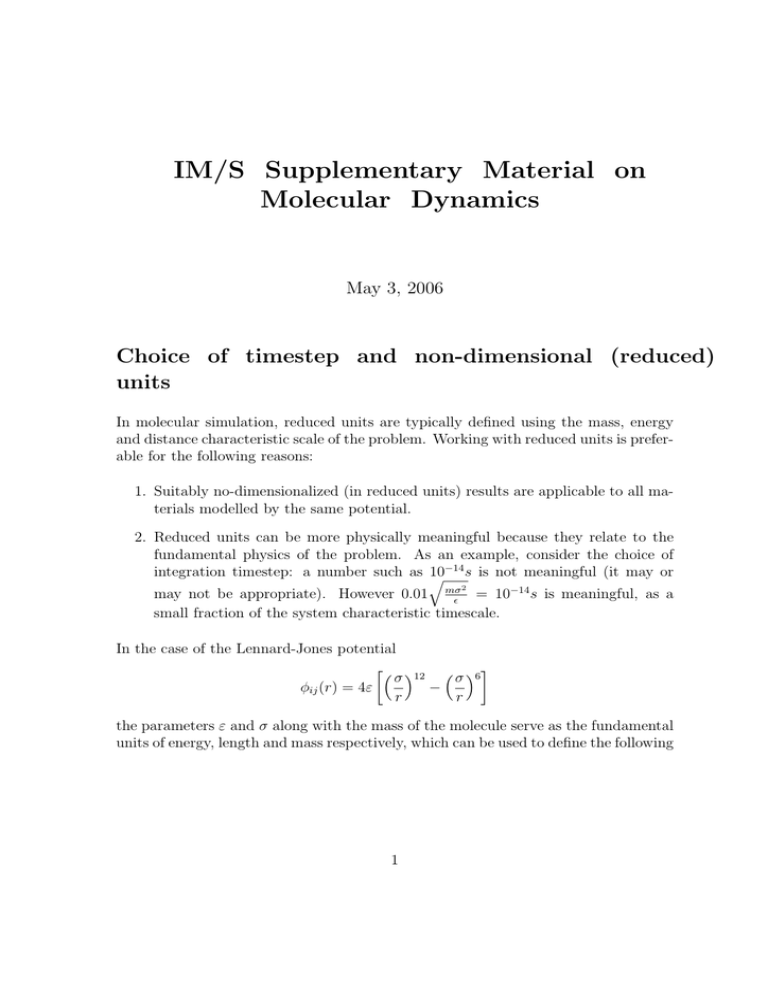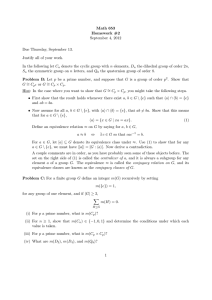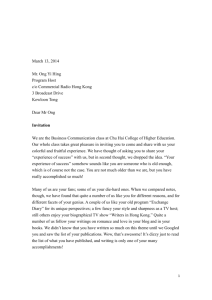Document 12886313
advertisement

IM/S Supplementary Material on
Molecular Dynamics
May 3, 2006
Choice of timestep and non-dimensional (reduced)
units
In molecular simulation, reduced units are typically defined using the mass, energy
and distance characteristic scale of the problem. Working with reduced units is preferable for the following reasons:
1. Suitably no-dimensionalized (in reduced units) results are applicable to all materials modelled by the same potential.
2. Reduced units can be more physically meaningful because they relate to the
fundamental physics of the problem. As an example, consider the choice of
integration timestep: a number such as �
10−14 s is not meaningful (it may or
2
may not be appropriate). However 0.01 mσǫ = 10−14 s is meaningful, as a
small fraction of the system characteristic timescale.
In the case of the Lennard-Jones potential
�� �
�
σ 12 � σ �6
φij (r) = 4ε
−
r
r
the parameters ε and σ along with the mass of the molecule serve as the fundamental
units of energy, length and mass respectively, which can be used to define the following
1
reduced units:
number density n⋆ = nσ 3
kT
ε
E
=
ε
temperature T ⋆ =
energy E ⋆
P σ3
ε
�
ε
t
=
mσ 2
pressure P ⋆ =
time t⋆
Using these units, the characteristic timescale for motion is t⋆ , so a reasonable
timestep will be δt = (0.001 − 0.01)t⋆ . This is sufficiently small in the sense that a
number of timesteps (100-1000) are used to discretize the characteristic timescale.
In the presence of more degrees of freedom (other than just translation e.g. bond
vibrations), the timestep needs to be much smaller than the characteristic timescale
of the fastest process. This may lead to “stiffness,” whereby the significantly faster
process (e.g. bond vibration) requires a much smaller timestep than the timescale of
interest (e.g. fluid flow) and causes limitations in simulation or even intractability.
In some cases, to avoid excessive cost, fast degrees of freedom that do not play an
important role in the physics of interest are frozen, e.g. bonds frozen at fixed
length and molecules treated as rigid (dumbbell).
Systems with non-smooth potentials or high molecular speeds will, in general,
require a smaller timestep. In the limit of “hard” collisions the interaction is not
treated through the equations of motion; instead momentum principles are preferable
to determine the “post-collision” state (for an example see notes on the hard-sphere
gas).
Clearly a compromise exists between accuracy and minimum number of timesteps.
Hydrodynamic effects, or thermally activated processes (such as diffusion in a solid),
are very troublesome because their characteristic timescales are much longer than
those of atomic motion. This causes trouble when simulating by MD. Monte Carlo
methods are one approach used to avoid these kinetic limitations. Acceleration methods is another.
Integration algorithms
Newton’s equations for all particles are typically integrated using a finite difference
method. In fact, integration of the equations of motion is fairly simple; the most
2
challenging and time-consuming part of an MD code is the calculation of the forces.
For this reason it is very important for an integration algorithm to allow the use of a
large timestep (minimize the number of force evaluations). It is also unreasonable to
expect the integration algorithm to follow particle trajectory as closely as possible for
all times: Because of the highly nonlinear nature of the many body problem, any two
trajectories that are close at time t diverge exponentially in time, so even a small error
(truncation) will cause the computer trajectory to diverge from the “true” trajectory.
It takes a few hundred timesteps for these two diverging trajectories to become
statistically uncorrelated. Fortunately this is not so disastrous. We need MD to calculate exact trajectories only for very short times (calculate correlation functions);
otherwise, our objective is to generate states that are consistent with the macroscopic constraints of the system of interest. In this sense, conservation of energy and
momentum are more important.
Integration algorithms can be divided into two categories:
1. Verlet type algorithms (cannot handle velocity dependent forces)
2. Predictor-corrector algorithms
The reason for the limited “selection” is that the integration algorithm does not make
a big difference. As discussed above, the most expensive part is the force calculation.
The Verlet algorithm
~r(t + δt) = 2~r(t) − ~r(t − δr) + δt2~a(t) + O(δt4 )
~r(t + δt) − ~r(t − δt)
~v (t) =
+ O(δt2 )
2δt
is a very simple, time-reversible algorithm that became very popular in the early days
of Molecular Dynamics. The Verlet algorithm has two main disadvantages:
1. ~v (t) errors O(δt2 ), ~v (t) only known after ~r(t + δt) is known (important in thermostating, for example).
2. Imprecision from a small term (δt2~a(t)) added to the difference of two large
terms (2~r(t) − ~r(t − δt)).
A modified version which addresses the above disadvantages is the “Leap-frog” algorithm:
�
�
1
~r(t) = ~r(t + δt) + δt~v t − δt
2
�
�
1
1
~v (t + δt) = ~v t − δt + δt~a(t)
2
2
� �
�
�
��
1
1
1
~v (t) =
~v t + δt + ~v t − δt
2
2
2
3
It gets its name from the fact that velocities and then coordinates leap over to provide
the next step values. It addresses the truncation error issues above and the fact that
velocities appear explicitly. However, note that it is algebraically equivalent to the
Verlet algorithm.
Predictor-corrector algorithms are in general expected to be more accurate and
also handle velocity-dependent forces that become important when rotational degrees
of freedom are considered. The general algorithm for a predictor-corrector integrator
is:
1. Predict positions, velocities at t + δt.
2. Evaluate the forces and accelerations from the new positions and velocities.
3. Correct the predicted positions, velocities using the new accelerations.
4. Go to 2) and repeat to convergence.
Although this type of algorithm would be expected to be significantly more accurate,
this is not necessarily the case, because molecular motion is heavily influenced by the
motion of neighbors. In other words, there is no reason to iterate for extra accuracy
based on the current locations of all neighbors when some of those have not been
updated yet. The extra cost associated with evaluation of the forces at the predicted
positions makes these types of algorithms not very popular.
An algorithm that does not require the re-evaluation of the forces from the positions, but allows for velocity-dependent forces, and calculates velocities correct to
0(δt3 ) in the absence of velocity dependent forces, is the Beeman algorithm shown
below in its “modified” version.
1.
~r(t + δt) = ~r(t) + δt~v (t) +
2.
~v P (t + δt) = ~v (t) +
3.
~a(t + δt) =
4.
δt2
[4~a(t) − ~a(t − δt)]
6
δt
[3~a(t) − ~a(t − δt)]
2
�
1 ~�
F {~r(t + δt), ~v P (t + δt)}
m
~v C (t + δt) = ~v (t) +
δt
[2~a(t + δt) + 5~a(t) − ~a(t − δt)]
6
5. Replace ~v P with ~v C and go to 3. Iterate to convergence. Note that this algorithm
does not require re-evaluation of the coordinate-dependent part of the forces
(which is the expensive one).
4
Boundary conditions
In MD simulations the number of particles is typically limited by computational
resources, and so systems are typically very small. This raises the issue of the role of
surface effects on the calculation. For this reason, a very popular boundary condition
is that of a periodic simulation cell that allows the system to interact with an infinite
number of replicas of itself (in all directions) thus minimizing the role of surface
effects.
In periodic boundary conditions the particle is usually taken to interact with only
the closest images of the other N − 1 molecules. This is called “minimum image
convention.” This is not necessarily the only correct approach. In other approaches
the particle may be allowed to interact with its own image. However, nowadays
computers are sufficiently fast that simulation cells are significantly larger than the
range of the interaction potential (see below about potential truncation) and thus the
question of a particle interacting with images of itself typically does not arise.
Potential truncation
The force calculation is by far the most computationally intensive part of the simulation mainly because of the large number of pairs of interacting particles. To limit the
simulation cost the potential is usually truncated at some distance r = rc at which it
approaches 0,
�
φ(rij )
rij ≤ rc
φ(rij ) =
0
rij > rc
i.e. only neighbors within the sphere of radius rc are considered. For a Lennard-Jones
model a typical cut-off used is rc = 2.5σ. At this distance φ(rc ) = 0.016 min{φ}.
This truncation makes the potential discontinuous at rc . Every time a molecule
crosses the r = rc boundary the total energy of the simulation changes leading to lack
of energy conservation. We can avoid this by shifting the potential function by φ(rc ),
that is
φ(rij ) =
�
φ(rij ) − φ(rc )
0
rij ≤ rc
rij > rc
Similar adjustments can be made to ensure continuity of higher order derivatives of
the potential function.
5
Neighbor lists
By implementing a cutoff radius we ensure that the force calculation is concerned with
a relatively small number of neighbors and no force is calculated for r > rc . Although
the computational savings are appreciable, the cost still scales as N 2 (neighbor search)
and it is thus prohibitive as N becomes large.
Verlet suggested a method to reduce the computational cost associated with calculation of forces: at the start of the simulation, a list is constructed of all the neighbors
of each molecule for which the pair separation is rl = rc + rs where rs = skin distance.
Over the next few time-steps the list is used in the force/energy calculation routine.
If the skin distance rs is chosen thick enough that within those timesteps no molecule
penetrates to within rc , the interactions are calculated correctly. This list is updated
periodically. Clearly, the key to an efficient and accurate simulation lies in the choice
of rs such that no frequent updates are required while at the same time no molecules
are omitted from the force calculation. As N grows however, the storage requirement
(each molecule has an associated list) of this method becomes prohibitive.
For large systems, cell methods are used. In this method the particles are sorted
into cells (organized in a regular lattice)that have sides larger than rc . Thus, when
searching for neighbors, only the current cell and neighboring cells need to be searched.
For 3D calculations 27N Nc interactions need to be computed instead of 12 N (N − 1).
Here Nc = MN3 where M is the number of cells per dimension. Taking advantage
of Newton’s third law this number can be further reduced to 13.5N Nc (≪ 12 N (N −
1) for N large) interactions requiring calculation. Also note that Nc is effectively a
constant and so this is an O(N ) method, that is, the computational savings compared
to 12 N (N − 1) increases as N increases.
Statistical error estimation
Sampling of macroscopic quantities (density, temperature, velocity) in a molecular
simulation is an inherently statistical process. Recall that a macroscopic property hAi was defined as a running average over a time series of microscopic data
once the simulation had reached steady state
1
hAi =
Δt
�
to +Δt
A(t′ )dt′ =
to
1 �
Ai
M i=1
where M is the number of samples collected. The second equality arises from the fact
that data are available in discrete form, typically at the end of each timestep. One
would expect that as M → ∞, our estimate approaches the true value of A, At , i.e.
hAi → At as M → ∞. Unfortunately, an infinite number of samples means infinite
6
simulation time. We are thus interested in quantifying the uncertainty in our estimate
of At . This is best formulated as a statistical question. We can analyze statistical
errors by using the central limit theorem. We expect this to be reasonable because
by sampling we essentially take the sum of a large number of random quantities.
Our estimate of uncertainty in evaluating At , is linked to the variance of the
distribution of A, σ 2 (A). In fact, a corollary of the central limit theorem is that the
variance in our estimate of At , σu2 , is related to σ(A) by
σu2 =
σ 2 (A)
Mi
where Mi is the number of independent samples taken.
This equation illustrates one of the major drawbacks associated with molecular
simulation: the standard deviation in the estimate of the mean decreases with the
square rootof the number of samples taken; this slow rate of convergence is the cause
of a significant part of the large computational cost associated with classical molecular
dynamics methods. One additional problem lies in the fact that subsequent samples
may not be independent (especially if the time between them is small) since they are
part of the dynamical trajectory of the system.
Let us define s, the statistical inefficiency, as the number of samples between two
statistically uncorrelated samples. Then,
σu2 =
σ 2 (A)
M
s
Unfortunately, s is unknown. To find s we can use the fact that the uncertainty σu can
in fact be measured by looking at how estimates of hAi vary around the distribution
average i.e. by measuring the actual variance of hAi. A number of estimates of hAi
for calculating the variance of hAi, σ 2 hAi, can be formed by averaging the data over
sub-blocks of length Mb
Mb
1 �
hAib =
Ai
Mb i=1
where hAib denotes that the average is only over Mb . As Mb → ∞ then the mb =
estimates of hAi will be independent and thus have variance
σb2
mb
1 �
(hAi) =
(hAibi − hAi)2
mb i=1
that can be related to the parent distribution by
σb2 (hAi) =
7
σ 2 (A)
Mb
s
Mb
M
thus s can be calculated from
Mb σb2 (hAi)
Mb →∞
σ 2 (A)
s = lim
Note that although we take the limit Mb → ∞, we also need to ensure that Mb is
sufficiently small that a statistically significant number of hAib samples are present
for a reliable estimation of σb2 (hAi) (i.e. mb � 1).
8




